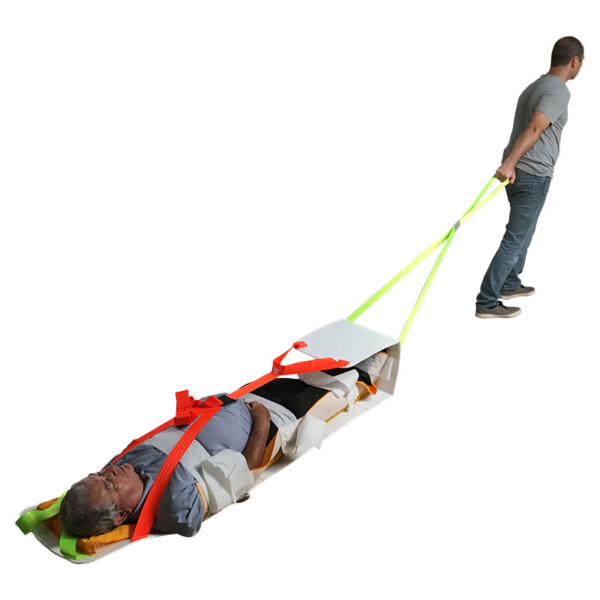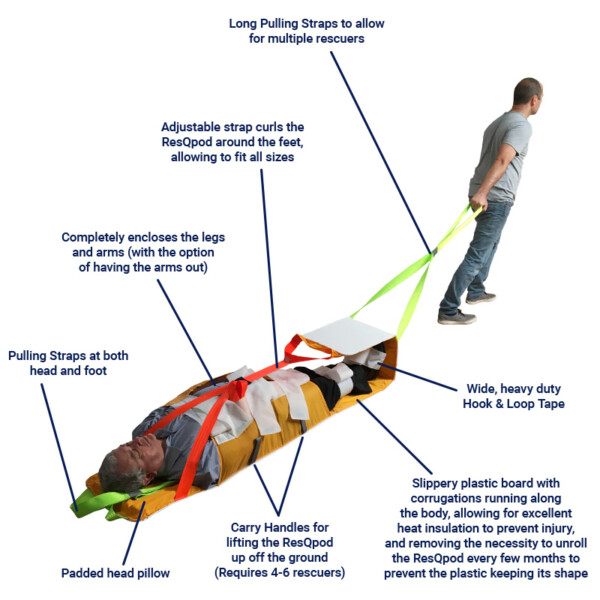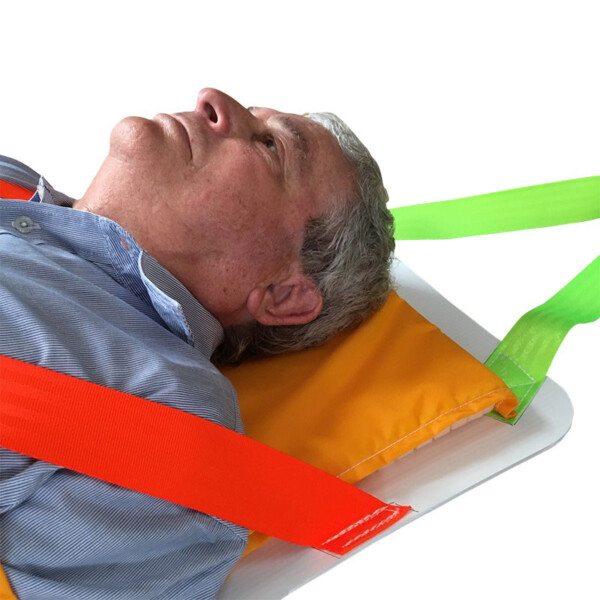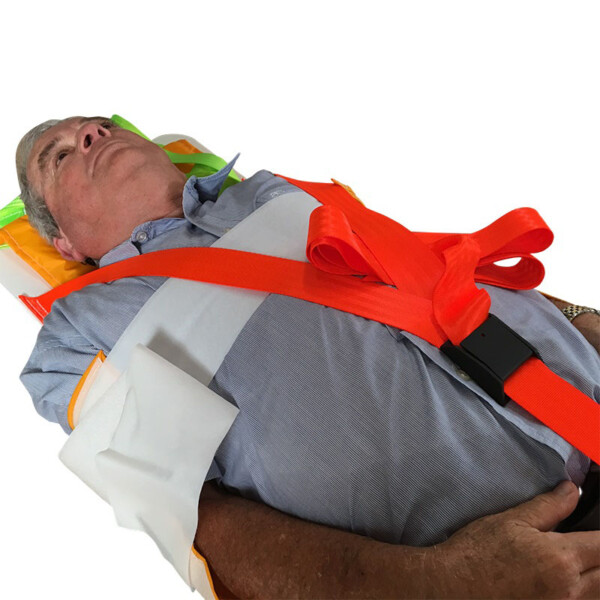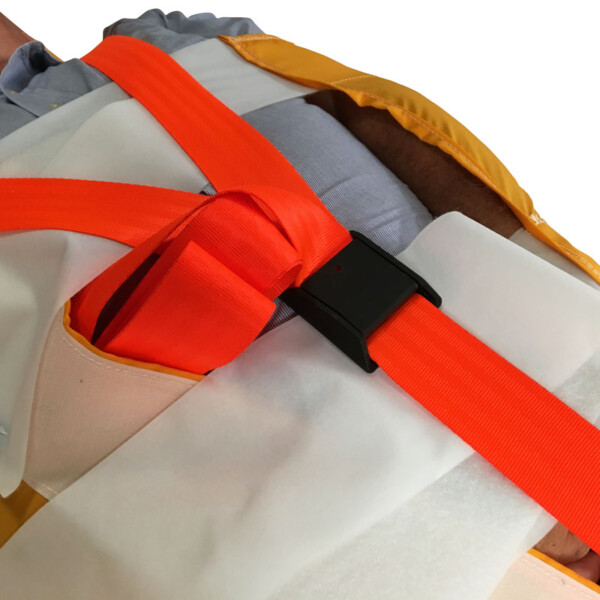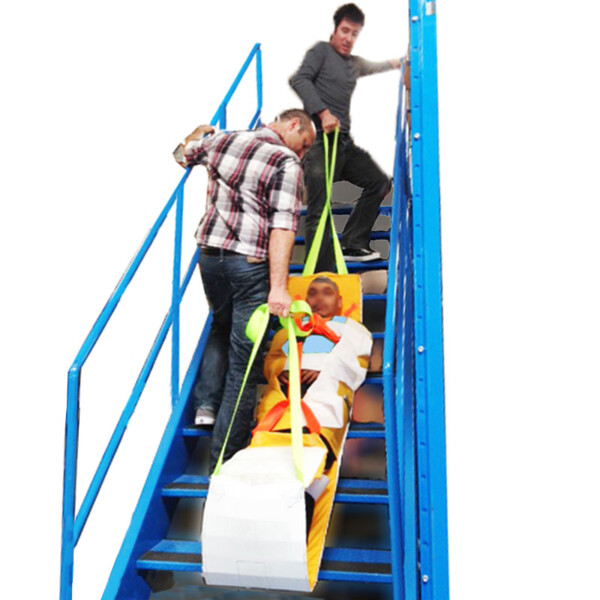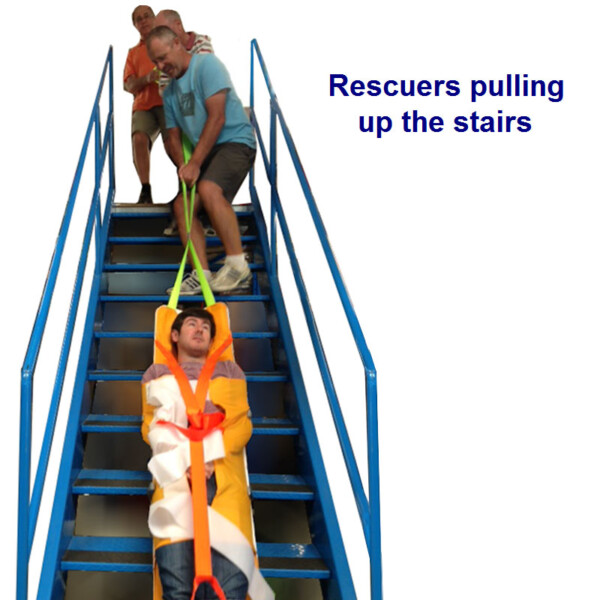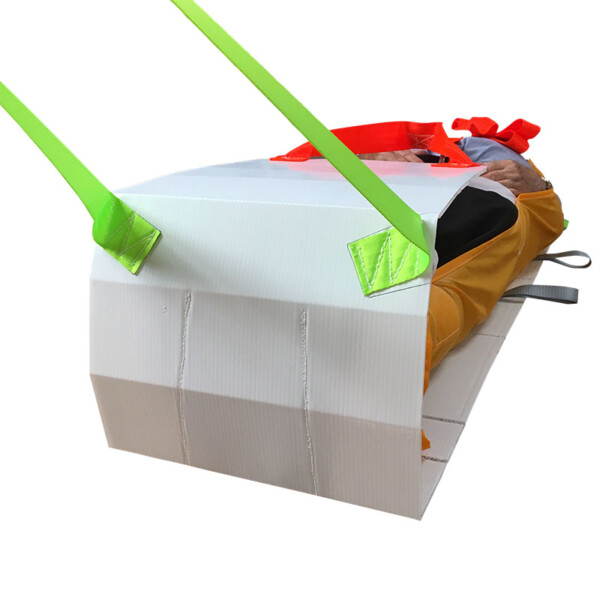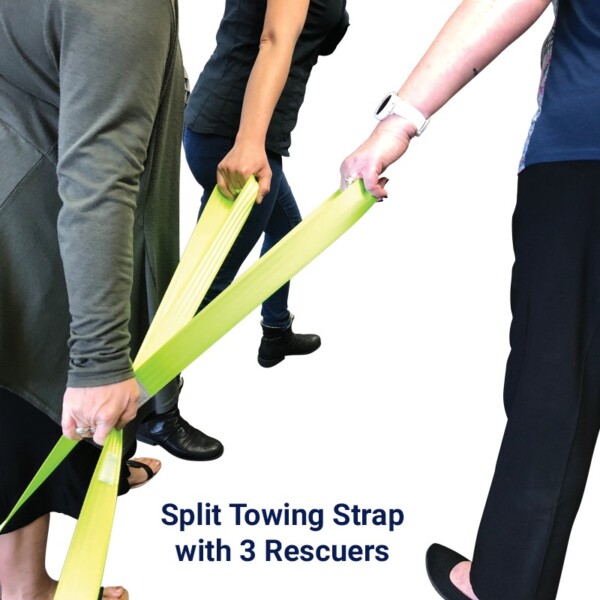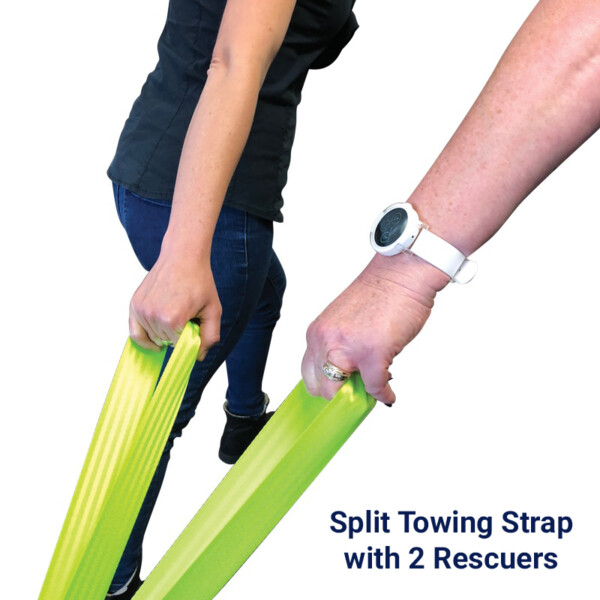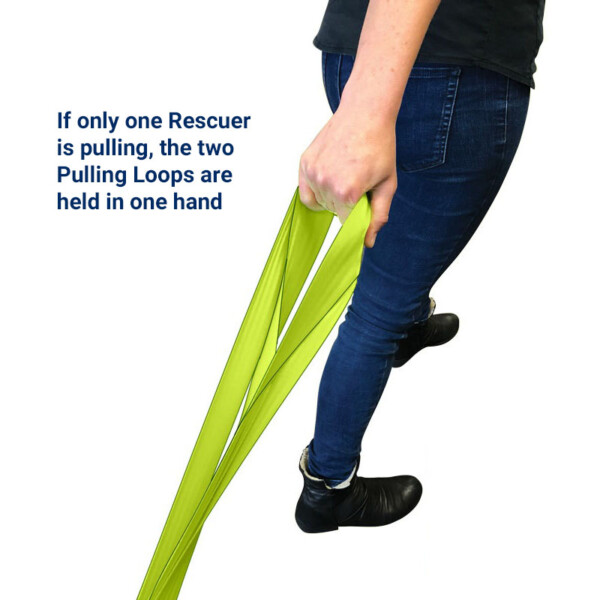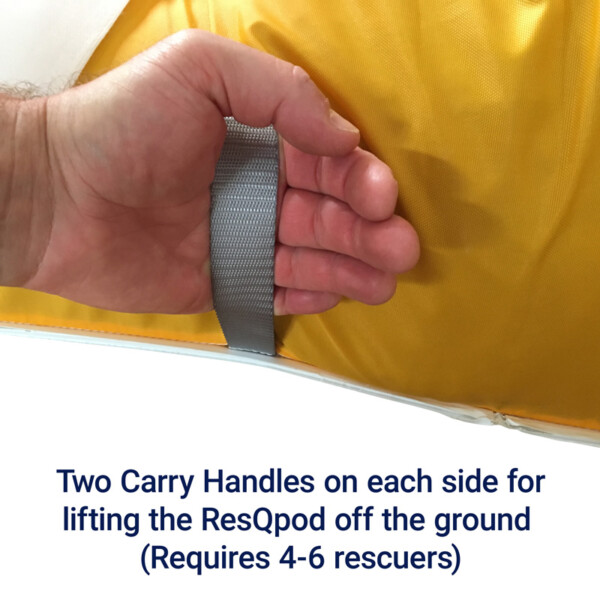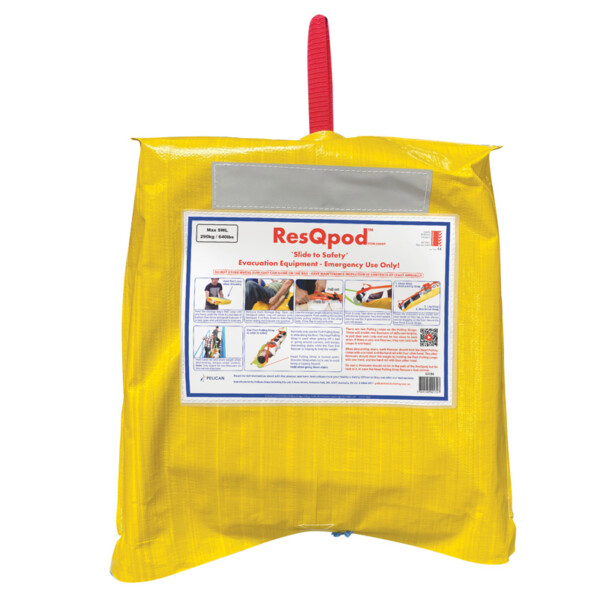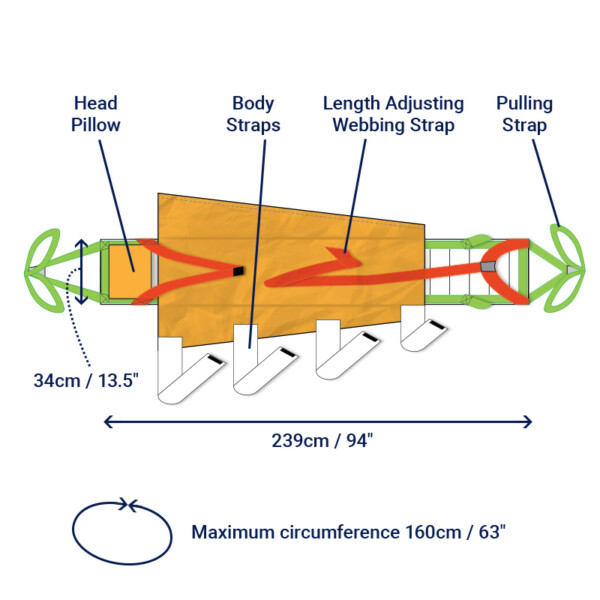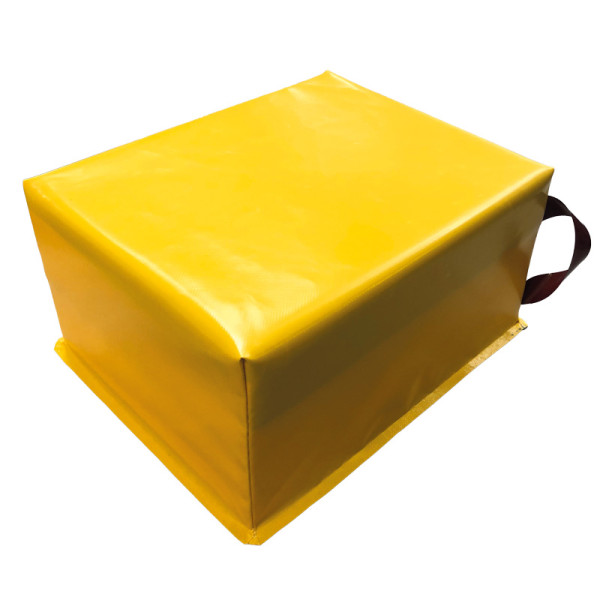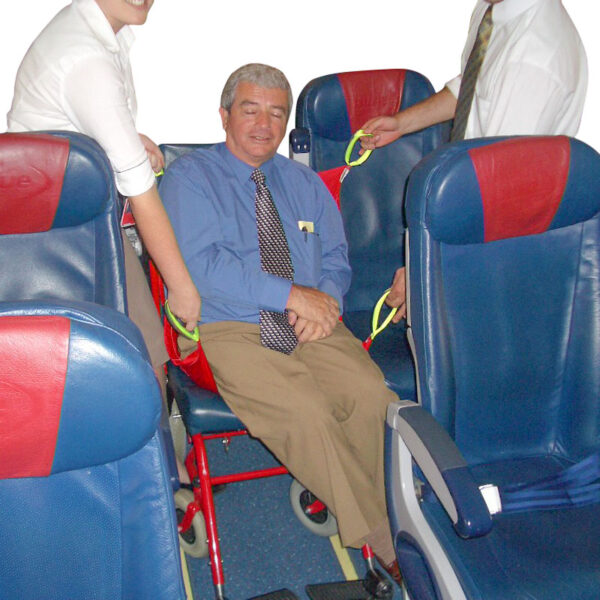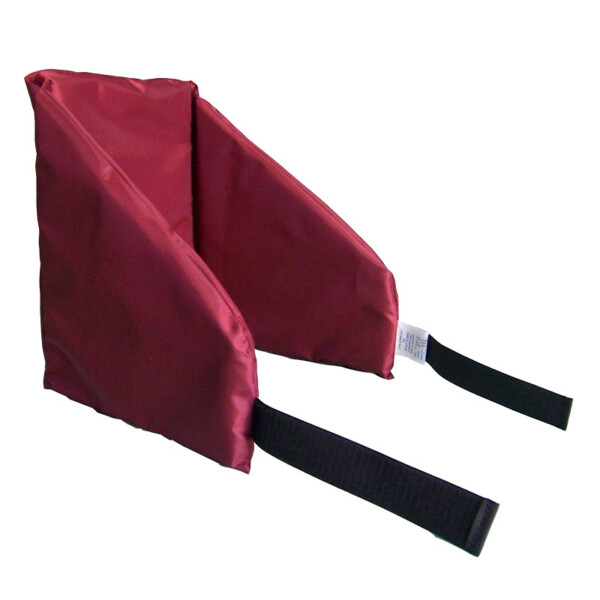Description
The ResQpod is designed to safely evacuate a non-ambulant person from a building in an emergency situation. The Evacuee may be in a wheelchair or they may not be able to walk down stairs, if the lifts are not available due to fire or an electrical failure.
The ResQpod is a bright yellow/gold colour with bright green Pulling Straps to stand out in poor light conditions. The yellow Storage Bag and Pulling Straps have some Hi Vis Tape made to Australian Standard 906.4. Many fires start at night. If the electricity is turned off, Rescuers need to find the ResQpod in poor light. Outside of the building, the bright colours and reflective tape will help the outside Rescuers see the ResQpod coming. This allows them to assist evacuation away from the building.
In any building over two storeys high, if there is a power failure or a fire, the electricity is turned off and the lifts or elevators then cannot be used. It is difficult and probably impossible, for people in wheelchairs or using Zimmer Frames or walking sticks, to walk down stairs. The ResQpod can be used in office buildings, theatres, libraries, hospitals, schools, etc. Even if a wheelchair user does not work in the building, a wheelchair user may be in the building when there is a power failure or fire, and they will not be able to use the stairs to evacuate. When not in use, the ResQpod can hang from a hook or be stored in a cupboard, ready to use when an evacuation is necessary.
This item is not suitable for most spiral staircases.
To Use
Take the ResQpod to the Patient. Remove the strap that is around the ResQpod and unfold the ResQpod.
When putting the Patient on top of the ResQpod, place their head on the pillow with their shoulders close to the edge of the pillow.
The methods outlined below are only some suggested ways of getting the Patient onto the ResQpod. Your manual handling advisor may have a better suggestion for this task.
If the Patient is in bed
Log roll the Evacuee onto the ResQpod. If their head is not on the pillow, the Rescuers can slide the Evacuee up into position.
If the Patient is in a chair
Place the ResQpod on the floor in front of the chair with the pillow near the Patient’s feet. If they are in a wheelchair, apply the brakes, remove the foot plates or swing them out of the way. Lift the Patient’s legs to pull them, so they slide down into the ResQpod. This is easier if a second Carer can hold the Patient under the arms to help them slide, remember this is only used for an emergency evacuation. It also may be possible to stand the Patient and have the ResQpod near the chair to lay the Patient onto the ResQpod. There may not be enough Carers, so always ask your Manual Handling Advisor to learn a safe method for patients and Carers.
When the Patient is on the ResQpod
Place the Evacuee’s arms on their stomachs, or hands on their laps and do up the Hook & Loop firmly. Do up the Hook & Loop around the upper and lower legs or around the feet of shorter Evacuees.
Attach the Orange Length Adjusting Strap to the Shoulder Strap. Pull the Length Adjusting Strap to shorten the length of the ResQpod. The shorter ResQpod is more secure for the Evacuee, and is easier to manoeuvre going around corners, and on stair landings. There are two Carry Handles on each side for lifting the ResQpod up off the ground (Requires 4-6 rescuers).
The Patient should be pulled clear of the building to a designated muster area approved by your facility.
It is important that all staff have manual handling training in using the ResQpod, so they will know how to use it in an emergency. When training, it may be better to stop the training by the escape door, because if the ResQpod is dragged across a driveway, the bottom surface may be scratched beyond repair. Proposed escape routes should be trialed for evacuation in different directions depending on where the fire may start. It may be necessary to move some furniture to allow more room to move.
Maintenance
We recommend you inspect annually, to ensure vermin have not caused any damage. The direction of the corrugations on the plastic board means that it is not necessary to unroll it every few months.
The full range of ResQproduct options are listed below. Click here to view the Features List for the range of Pelican evacuation devices.
 |
ResQsheet | Stored under the Patient’s mattress on the bed and is ready to use, with the Patient then evacuated with their mattress. Slides well on most vinyl floors. |
 |
ResQsheet for Vinyl & Carpet | Same as the ResQsheet above, but with a built-in white plastic slide board underneath. Slides well on all floor surfaces including Vinyl & Carpet. |
 |
ResQsheet for Vinyl & Carpet – Deep & Airflow | A special version of our ResQsheet for Vinyl & Carpet, made to fit deep mattress beds, and can also be used with pressure care air-flow mattresses. |
 |
ResQme | This is kept in storage and taken to a Patient who needs to be evacuated. A budget option evacuation device. |
 |
ResQpod | Same as the ResQme above, but with more Cross Straps to contain the Patient. |
 |
ResQmat | Same as the ResQme and ResQpod above, but with a built-in mini-mattress for comfort, and the side material can enclose the Patient. |
 |
ResQslide Board & Chair Strap Kit | The ResQslide Board & Chair Strap Kit is used to slide someone from a wheelchair to an evacuation device on the floor, such as the ResQmat, ResQpod or ResQme which can slide down stairs. |
Technical:
Item # 220RP
Safe Working Load (SWL): 290kg / 639lbs (Lifting using all straps)
Size:
- Height: Fits people 136cm to 192cm (54″ to 76″)
- Width: Fits people to a maximum of 160cm (63″)
Note: There is no Australian or International Standard for this product, therefore we have adopted the testing requirements as set out in ISO 10535:2011 (Hoists for the transfer of disabled persons). This Standard covers testing for mechanical lifting hoists and associated lifting slings. It includes a method for obtaining a SWL for a lifting sling which lifts a person’s entire weight, which Pelican’s range of slings adhere to. We use the same materials, thread and method of stitching our slings, as we do for the ResQ products. Because people’s weight and size may be distributed differently between the chest, stomach and legs, it may be possible that the Cross Straps do not fit some bariatric people. If possible, we recommend this is tested before an emergency occurs. If this is the case, please contact us as we can supply extension Cross Straps.
Cleaning:
Cleaning & Storage: Keep away from direct UV rays. Keep in a clean and dry environment. Do not subject to extreme temperatures or environment changes. Wipe clean with a hospital grade disinfectant. The foam pillow can be separated from the ResQpod. Remove the pillow foam and wash in a tub. Squeeze to remove excess water and air dry in the shade. Without the foam, the product can be washed up to 80°C (176°F). Air dry before use and storage. Inspect after cleaning, and report any concerns or damage that may affect use in an emergency, and then withdraw from service and seek advice. Normally only a ResQpod that is used for staff training may need cleaning if it is soiled during an exercise. If the ResQpod is used in an emergency the replacement cost should be covered in an insurance claim.
Annual Inspection: Inspect the product once a year and more frequently if the storage place or conditions may affect the product. Open bag, remove and open the ResQpod to full length. Check the condition of all parts and materials. Report to management any concerns or damage which may affect use in an emergency and withdraw from service and seek advice. Maintain records of inspection and findings.
Important:
The ResQpod is slippery. Do not step into or stand on it. Keep it away from children. Have regular training from a Manual Handling Advisor on how to use the ResQpod as part of the emergency evacuation education. After training, with someone already on the floor, it should take about 1 minute 25 seconds to start pulling them to safety.
Note for Trainers: This product may not be suitable for use on some circular staircases. Ensure all doorways are wide enough to allow this product to pass through. Allow caution when turning corners fast as a high lateral force may make the product roll over, although we are not aware of this ever happening. If evacuating a large Bariatric person, it may be necessary to have more than one person pulling. It is good to have the total weight of the people pulling, near to or equal to the weight of the evacuee. Also using the Extension Straps (sold separately) will lengthen the Pulling Straps so more people can hold the straps without being too close to each other. Remember more Rescuers will be needed to hold the weight back when descending stairs.
General Manual Handling Warning: Manual Handling products are designed to assist carers to help patients. They will not make the carer stronger or fitter, but with correct training and use of the products, should make manual handling easier and safer for both staff and patients. When training, practise with an able-bodied colleague. If any procedure is not comfortable or is difficult and puts the carer or patient in a dangerous position, the participants should call out to stop the manoeuvre, recover and recommence. Never jeopardise your health by straining, twisting or being incorrectly positioned when manual handling. Always select the most appropriate equipment for the patient’s current condition and if in doubt, use mechanical equipment. Ask your Manual Handling adviser for individual guidance.
Correct Buckle Threading: Click here to view a video showing the correct way to thread a buckle onto the webbing. It is vital that the buckles on this product are correctly fitted. Contact us if you need to order a replacement buckle if one is broken.

